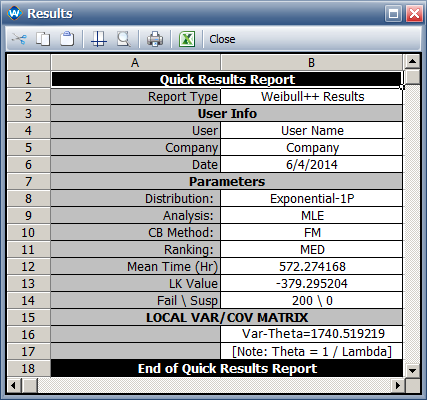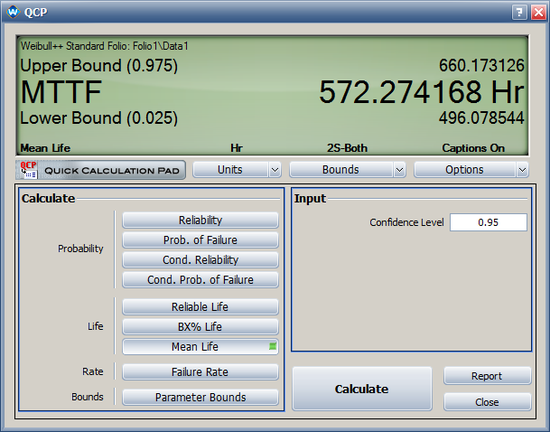1P-Exponential MLE Solution for Interval Data: Difference between revisions
Jump to navigation
Jump to search
Kate Racaza (talk | contribs) No edit summary |
Kate Racaza (talk | contribs) No edit summary |
||
| (5 intermediate revisions by the same user not shown) | |||
| Line 1: | Line 1: | ||
{{Reference Example}} | {{Reference Example}} | ||
This example validates the calculations for the MLE solution, likelihood ratio bound and Fisher Matrix bound for a 1-parameter exponential distribution with interval data in Weibull++ standard folios. | |||
{{Reference_Example_Heading1}} | {{Reference_Example_Heading1}} | ||
Example 7.1 on page 154 in book ''Statistical Methods for Reliability Data'' by Dr. Meeker and Dr. Escobar, John Wiley & Sons, 1998. The sample size of 200 data is used here. | Example 7.1 on page 154 in the book ''Statistical Methods for Reliability Data'' by Dr. Meeker and Dr. Escobar, John Wiley & Sons, 1998. The sample size of 200 data is used here. | ||
| Line 34: | Line 33: | ||
{{Reference_Example_Heading3}} | {{Reference_Example_Heading3}} | ||
The cumulative distribution function for an exponential distribution is: | The cumulative distribution function for an exponential distribution is: | ||
| Line 39: | Line 39: | ||
The ML estimate <math>\hat{\theta}\,\!</math> = 572.3, and the standard deviation is <math>se_{\hat\theta}\,\!</math> = 41.72. Therefore the variance is 1740.56. | The ML estimate <math>\hat{\theta}\,\!</math> = 572.3, and the standard deviation is <math>se_{\hat\theta}\,\!</math> = 41.72. Therefore the variance is 1740.56. | ||
The 95% 2-sided confidence interval for <math>{\theta}\,\!</math> are: | |||
* Based on the likelihood ratio, the confidence interval is [498, 662]. The calculation is based on | * Based on the likelihood ratio, the confidence interval is [498, 662]. The calculation is based on | ||
::<math>-2ln\left [ \frac{L(\theta)}{L(\hat{\theta})} \right ] = X^{2}_{(0.90,1)}\,\!</math> | |||
::<math>-2ln\left [ \frac{L(\theta)}{L(\hat{\theta})} \right ] = | |||
| Line 54: | Line 55: | ||
::<math>\begin{alignat}{2} | ::<math>\begin{alignat}{2} | ||
[\theta_{L},\theta_{U}]&= \hat{\theta}exp(\pm 1.96\times \frac{se_{\hat{\theta}}}{\hat{\theta}})\\ | [\theta_{L},\theta_{U}]&= \hat{\theta}exp\left(\pm 1.96\times \frac{se_{\hat{\theta}}}{\hat{\theta}}\right)\\ | ||
&=\left [572.3\times exp(-1.96\times\ | &= \left[572.3\times exp \left(-1.96\times\frac{41.72}{572.3}\right),572.3\times exp \left(1.96\times\frac{41.72}{572.3}\right)\right]\\ | ||
&= [496,660]\\ | &= [496,660]\\ | ||
\end{alignat}</math> | \end{alignat}</math> | ||
| Line 63: | Line 64: | ||
The ML estimator for <math>\theta\,\!</math> and its variance are 572.27 and | The ML estimator for <math>\theta\,\!</math> and its variance are 572.27 and 1740.52, respectively. They are given below. | ||
[[Image:1PE_interval_data.png|center]] | [[Image:1PE_interval_data.png|center]] | ||
The ML estimator for <math>\theta\,\!</math> and the variance are the same as the values given in the book | The ML estimator for <math>\theta\,\!</math> and the variance are the same as the values given in the book. | ||
The 95% 2-sided confidence interval for <math>\theta\,\!</math> are: | The 95% 2-sided confidence interval for <math>\theta\,\!</math> are: | ||
* Based on the likelihood ratio (Select LRB for the confidence bound), the confidence interval is | * Based on the likelihood ratio (Select LRB for the confidence bound), the confidence interval is: | ||
[[Image:1PE_interval_data_qcp.png|center|550 px]] | |||
* Based on lognormal approximation (select FM for the bound method), the confidence bounds are: | |||
[[Image:1PE_interval_data_qcp_FM.png|center|550 px]] | |||
Latest revision as of 16:16, 28 September 2015
New format available! This reference is now available in a new format that offers faster page load, improved display for calculations and images and more targeted search.
As of January 2024, this Reliawiki page will not continue to be updated. Please update all links and bookmarks to the latest references at Weibull examples and Weibull reference examples.



